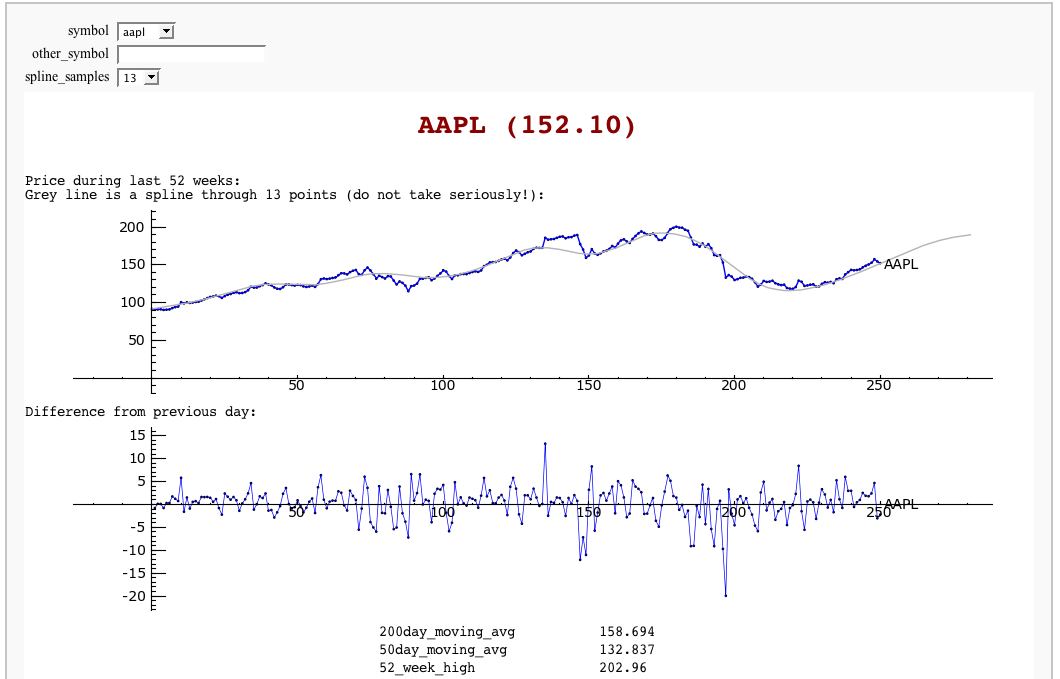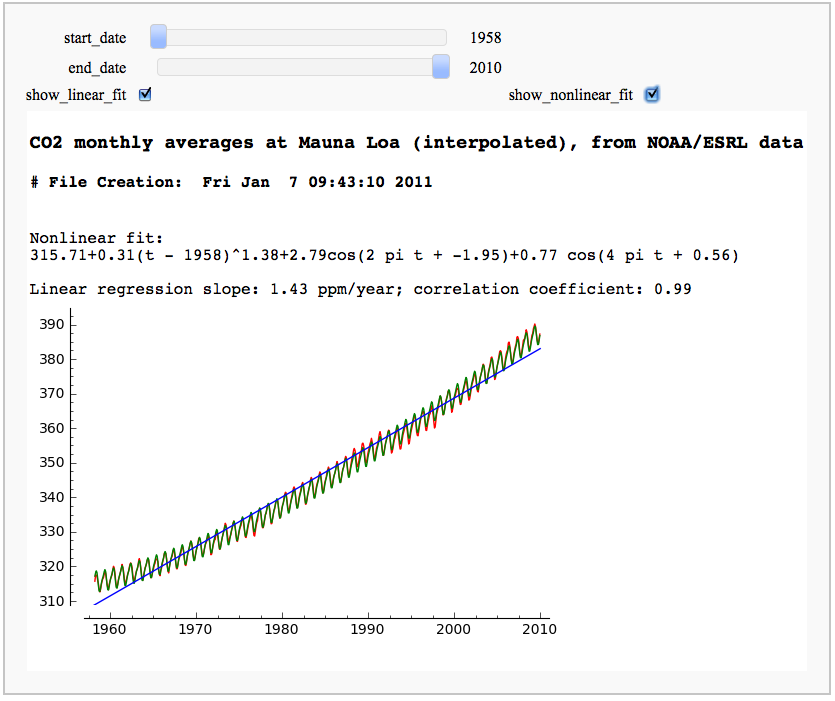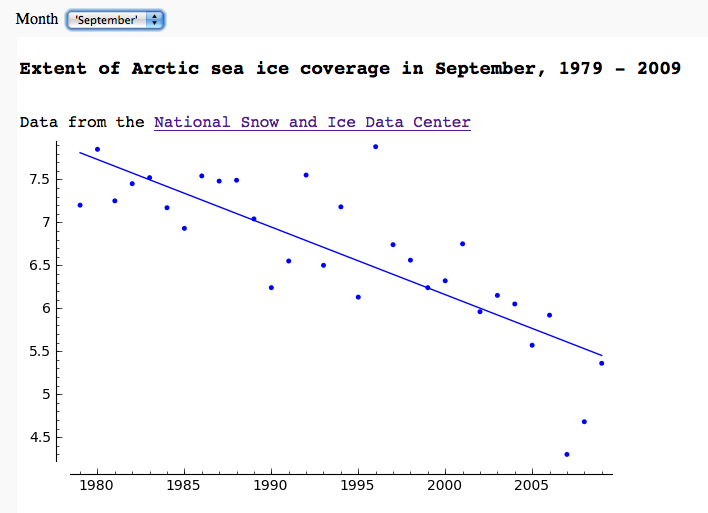|
Size: 7558
Comment:
|
Size: 10753
Comment:
|
| Deletions are marked like this. | Additions are marked like this. |
| Line 1: | Line 1: |
| = Sage Interactions - Calculus = goto [:interact:interact main page] = Web applications = == Stock Market data, fetched from Yahoo and Google == |
= Sage Interactions - Web applications = goto [[interact|interact main page]] <<TableOfContents>> == Stock Market data, fetched from Yahoo and Google FIXME == |
| Line 9: | Line 9: |
| {{{ | (Need to fix plotting warnings as well as some stocks give index errors (like bsc, etc.) {{{#!sagecell |
| Line 119: | Line 121: |
| k = Y.keys(); k.sort() | k = list(Y); k.sort() |
| Line 126: | Line 128: |
| attachment:stocks.png | {{attachment:stocks.png}} |
| Line 131: | Line 133: |
| While support for R is rapidly improving, scipy.stats has a lot of useful stuff too. This only scratches the surface. {{{ import urllib2 as U |
One can do many things with scipy.stats. This only scratches the surface. {{{#!sagecell from scipy.optimize import leastsq import urllib.request as U |
| Line 135: | Line 138: |
| co2data = U.urlopen('ftp://ftp.cmdl.noaa.gov/ccg/co2/trends/co2_mm_mlo.txt').readlines() | import time current_year = time.localtime().tm_year co2bytedata = U.urlopen('ftp://ftp.cmdl.noaa.gov/ccg/co2/trends/co2_mm_mlo.txt').readlines() co2data = [d.decode() for d in co2bytedata] |
| Line 144: | Line 150: |
| trdf = RealField(16) @interact def mauna_loa_co2(start_date = slider(1958,2010,1,1958), end_date = slider(1958, 2010,1,2009)): |
npi = RDF(pi) @interact(layout=[['start_date'],['end_date'],['show_linear_fit','show_nonlinear_fit']]) def mauna_loa_co2(start_date = slider(1958,current_year,1,1958), end_date = slider(1958, current_year,1,current_year-1), show_linear_fit = checkbox(default=True), show_nonlinear_fit = checkbox(default=False)): |
| Line 149: | Line 155: |
| sel_data = [[q[2],q[4]] for q in datalines if start_date < q[2] < end_date] | html(htmls1+htmls2) sel_data = [[q[2],q[4]] for q in datalines if start_date <= q[2] <= end_date] outplot = list_plot(sel_data, plotjoined=True, rgbcolor=(1,0,0)) if show_nonlinear_fit: def powerlaw(t,a): return sel_data[0][1] + a[0]*(t-sel_data[0][0])^(a[1]) def res_fun(a): return [q[1]-powerlaw(q[0],a) for q in sel_data] def fitcos(t,a): return a[0]*cos(t*2*npi+a[1])+a[2]*cos(t*4*npi+a[3]) def res_fun2(a): return [q[1]-fitcos(q[0],a) for q in resids] a1 = leastsq(res_fun,[1/2.4,1.3])[0] resids = [[q[0],q[1] - powerlaw(q[0],a1)] for q in sel_data] a2 = leastsq(res_fun2, [3,0,1,0])[0] r2_plot = list_plot([[q[0],powerlaw(q[0],a1)+fitcos(q[0],a2)] for q in resids], rgbcolor='green',plotjoined=True) outplot = outplot + r2_plot var('t') formula1 = '%.2f+%.2f(t - %d)^%.2f'%(sel_data[0][1],a1[0],sel_data[0][0],a1[1]) formula2 = '%.2fcos(2 pi t + %.2f)+%.2f cos(4 pi t + %.2f)'%(a2[0],a2[1],a2[2],a2[3]) html('Nonlinear fit: <br>%s<br>'%(formula1+'+'+formula2)) if show_linear_fit: slope, intercept, r, ttprob, stderr = Stat.linregress(sel_data) outplot = outplot + plot(slope*x+intercept,start_date,end_date) html('Linear regression slope: %.2f ppm/year; correlation coefficient: %.2f'%(slope,r)) var('x,y') |
| Line 152: | Line 183: |
| slope, intercept, r, ttprob, stderr = Stat.linregress(sel_data) html(htmls1+htmls2+'<h4>Linear regression slope: ' + str(trdf(slope)) + ' ppm/year; correlation coefficient: ' + str(trdf(r)) + '</h4>') var('x,y') show(list_plot(sel_data, plotjoined=True, rgbcolor=(1,0,0)) + plot(slope*x+intercept,start_date,end_date), xmin = start_date, ymin = c_min-2, axes = True, xmax = end_date, ymax = c_max+3, frame = False) }}} attachment:co2c.png |
show(outplot, xmin = start_date, ymin = c_min-2, axes = True, xmax = end_date, ymax = c_max+3, frame = False) }}} {{attachment:co2c.png}} == Arctic sea ice extent data plot, fetched from NSIDC == by Marshall Hampton {{{#!sagecell import urllib2, csv months = ['Jan','Feb','Mar','Apr','May','Jun','Jul','Aug','Sep','Oct','Nov','Dec'] longmonths = ['January','February','March','April','May','June','July','August','September','October','November','December'] @interact def iceplotter(month = selector(zip(range(1,13),longmonths),default = (4, 'April'),label="Month")): month_str = months[month-1] + '/N_%02d_area.txt'%(month) dialect=csv.excel dialect.skipinitialspace = True icedata_f = urllib2.urlopen('ftp://sidads.colorado.edu/DATASETS/NOAA/G02135/%s'%month_str) cr = csv.reader(icedata_f,delimiter=' ', dialect=dialect) icedata = list(cr) icedata = [x for x in icedata[1:] if len(x)==6 and N(x[5])>0] lp = list_plot([[N(x[0]),N(x[4])] for x in icedata]) def lin_regress(xdata, ydata): xmean = N(mean(xdata)) ymean = N(mean(ydata)) xm = vector(RDF,[q-xmean for q in xdata]) ym = vector(RDF,[q-ymean for q in ydata]) xy = xm.inner_product(ym) xx = xm.inner_product(xm) slope = xy/xx intercept = ymean - slope*xmean return slope, intercept years = [N(x[0]) for x in icedata] ice = [N(x[4]) for x in icedata] slope, inter = lin_regress(years,ice) reg = plot(lambda x:slope*x+inter,(min(years),max(years))) html('<h3>Extent of Arctic sea ice coverage in %s, %d - %d</h3>'%(longmonths[month-1],min(years),max(years))) html('Data from the <a href="http://nsidc.org/">National Snow and Ice Data Center</a>') show(lp+reg, figsize = [7,4]) }}} {{attachment:seaice.png}} |
| Line 162: | Line 230: |
| {{{ | {{{#!sagecell |
| Line 173: | Line 241: |
| print url | print(url) |
| Line 176: | Line 244: |
| attachment:interact_with_google_chart_api.png | {{attachment:interact_with_google_chart_api.png}} |
Sage Interactions - Web applications
goto interact main page
Contents
Stock Market data, fetched from Yahoo and Google FIXME
by William Stein
(Need to fix plotting warnings as well as some stocks give index errors (like bsc, etc.)

CO2 data plot, fetched from NOAA
by Marshall Hampton
One can do many things with scipy.stats. This only scratches the surface.

Arctic sea ice extent data plot, fetched from NSIDC
by Marshall Hampton

Pie Chart from the Google Chart API
by Harald Schilly

